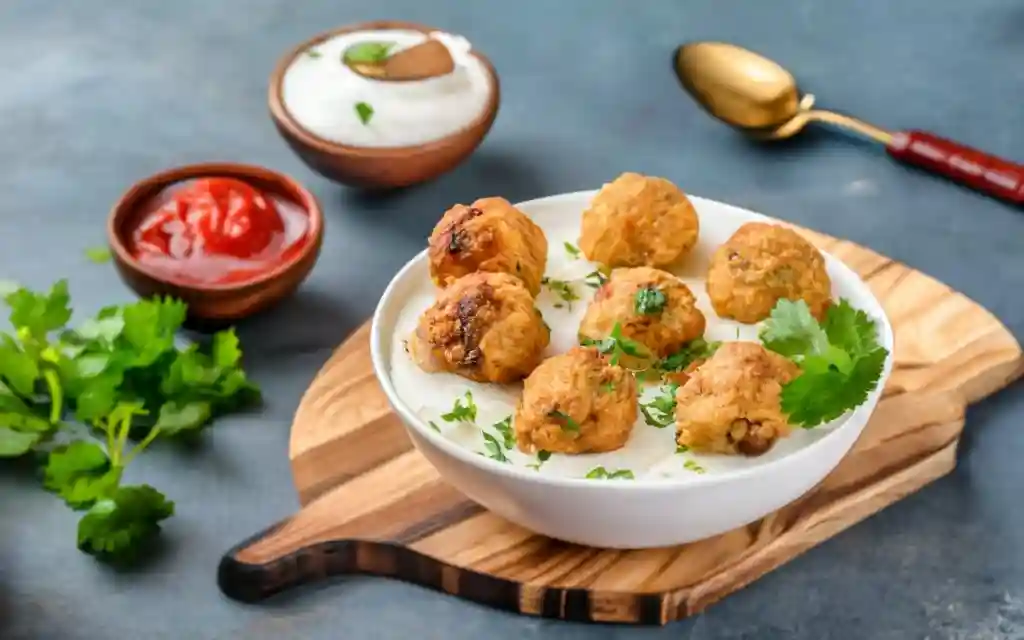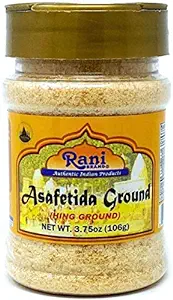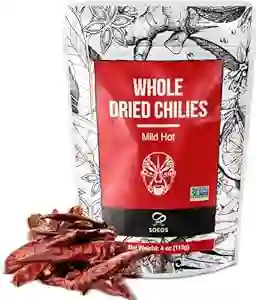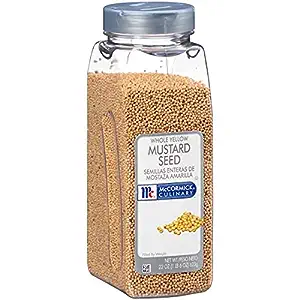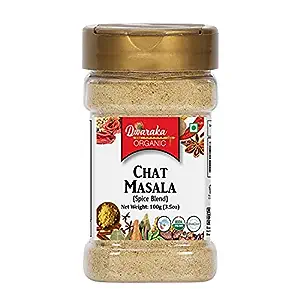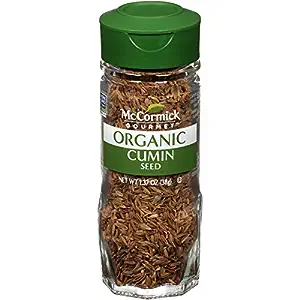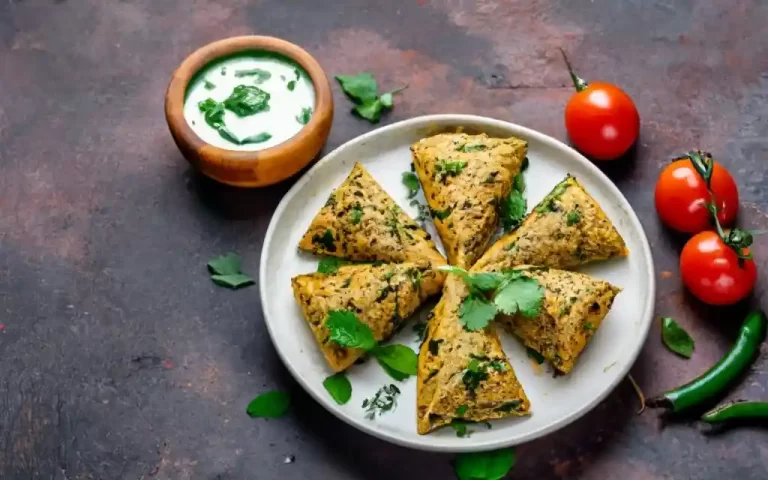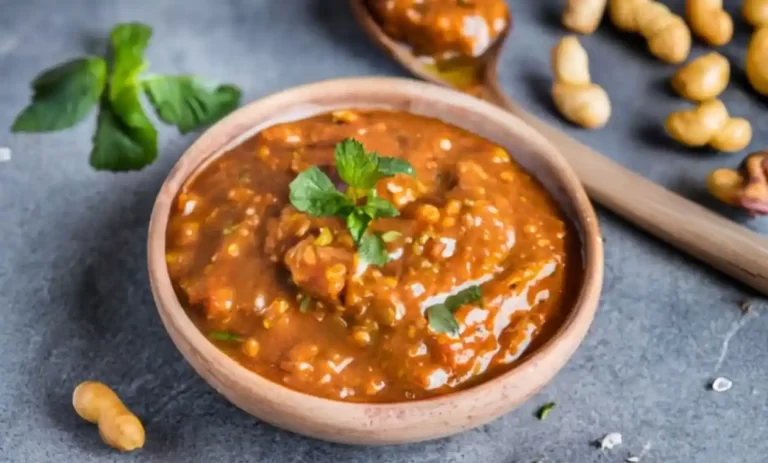Discover Delicious Dahi Vada Recipes | Taste Recipe
The Art of Dahi Vada: Try These Recipes
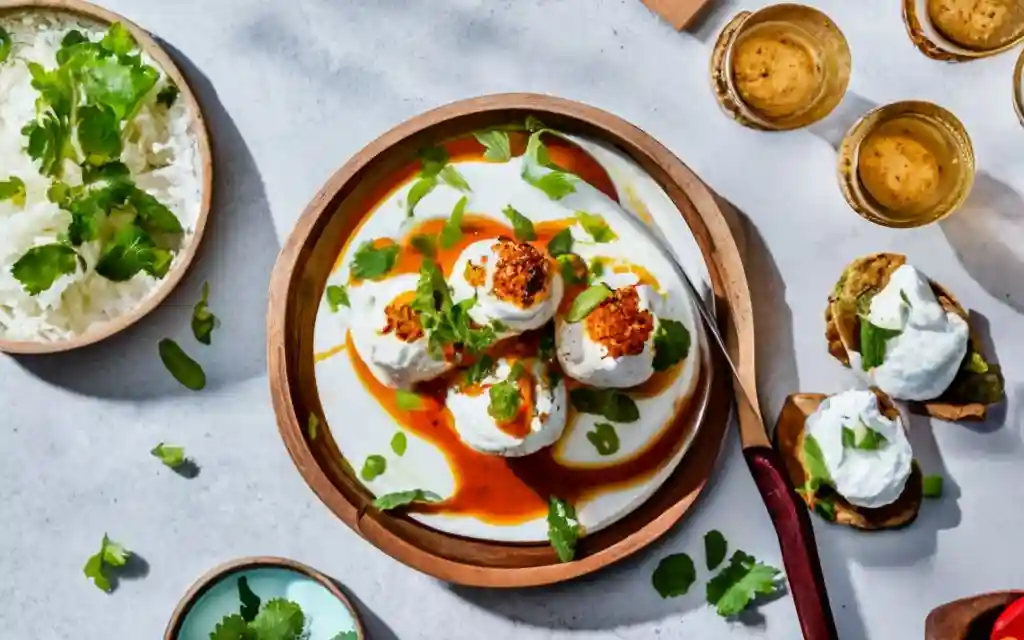
If there’s one dish that encapsulates the vibrant tapestry of Indian cuisine, it’s the beloved Dahi Vada. These delectable little treats, made from lentil fritters soaked in creamy yogurt and generously adorned with a symphony of spices and chutneys, are not just a dish; they’re a celebration of flavor, culture, and tradition.
Popularity and Significance: A Culinary Gem
Dahi Vada holds a special place in the hearts and taste buds of millions across India. It’s a ubiquitous presence at family gatherings, street food stalls, and festive feasts. The dish’s popularity transcends regional boundaries, making it a beloved staple from north to south and east to west.
But Dahi Vada isn’t just about its delicious taste; it carries a rich history and cultural significance. This dish has been a part of Indian culinary heritage for generations, passed down through kitchens as a cherished tradition. It’s a symbol of the warm hospitality that defines Indian culture, often served to guests as a welcoming gesture.
Setting the Stage for Culinary Adventure
As we embark on this culinary journey to explore the world of Dahi Vada, prepare to be captivated by its myriad flavors and textures. We’ll walk you through the essential ingredients, share the secrets behind various styles of Dahi Vada, and offer tips to help you create this iconic dish in your own kitchen.
So, whether you’re a seasoned cook looking to perfect your Dahi Vada recipe or a curious food enthusiast eager to try something new, join us as we dive into the world of Dahi Vada, where every bite tells a story, and every spoonful is a celebration of India’s diverse culinary heritage.
Get ready to tantalize your taste buds and discover the magic of Dahi Vada!
Ingredients: Crafting the Perfect Dahi Vada
Before we dive into the intricacies of preparing this delightful Indian dish, let’s take a closer look at the key players that come together to create the magic of Dahi Vada. Here’s a comprehensive list of ingredients you’ll need:
For the Vada (Lentil Fritters):
- Urad Dal (Black Gram Dal): This split and dehusked black gram lentil is the star of the show. Urad dal is known for its creamy texture, which is essential for the soft interior of the vada.
- Rice: Rice is often added to the urad dal to enhance crispiness and texture.
- Green Chilies: These provide the characteristic heat to the vada. Adjust the quantity to suit your spice preference.
- Ginger: Fresh ginger adds a zesty, aromatic note to the vada.
- Cumin Seeds: Cumin seeds contribute a mild earthy flavor.
- Asafoetida (Hing): Just a pinch of asafoetida adds a unique flavor and aids in digestion.
- Salt: To taste, for seasoning.
For the Dahi (Yogurt):
- Yogurt: Use fresh, plain yogurt, preferably not too sour, to create the creamy base for Dahi Vada.
For the Tempering (Tadka):
- Mustard Seeds: These add a delightful crunch and a burst of flavor when tempered.
- Curry Leaves: Curry leaves infuse the tempering with their distinct aroma.
- Dried Red Chilies: For a touch of spiciness in the tempering.
- Asafoetida (Hing): A pinch of asafoetida adds depth to the tempering.
For Garnish and Accompaniments:
- Tamarind Chutney: This sweet and tangy chutney complements the vada’s flavors.
- Green Chutney: A fresh coriander-mint chutney adds a vibrant kick.
- Roasted Cumin Powder: This ground spice lends an earthy note to the dish.
- Red Chili Powder: For an extra touch of heat.
- Chopped Coriander Leaves: Fresh coriander leaves provide a burst of color and freshness.
Now that you’re acquainted with the cast of characters, it’s time to roll up your sleeves and start creating your own batch of Dahi Vada. Each ingredient plays a crucial role in the symphony of flavors, ensuring that every bite is a delightful experience.
In the upcoming sections, we’ll guide you through the steps to transform these humble ingredients into a masterpiece of Indian cuisine. So, gather your supplies, and let’s get started on our culinary adventure!
Traditional Dahi Vada
Dahi Vada, in its traditional form, is a timeless classic that has been savored by generations of food enthusiasts. It’s a dish that encapsulates the essence of Indian culinary heritage and delivers a burst of flavors with every bite.
Explaining the Traditional Style:
The traditional Dahi Vada is all about achieving the perfect balance of flavors and textures. Its unique characteristics lie in the following key elements:
- Soft and Spongy Vada: The lentil fritters (vada) are soaked until they become incredibly soft and spongy. When you take a bite, they practically melt in your mouth.
- Creamy Yogurt: The vada is generously dunked in fresh, creamy yogurt, which acts as a soothing contrast to the spices used in the dish.
- Sweet and Tangy Chutneys: Traditional Dahi Vada is often served with a drizzle of sweet tamarind chutney and a dollop of spicy green chutney. This combination of sweet and spicy chutneys creates an explosion of flavors.
Ingredients:
- Urad Dal (Black Gram Dal)
- Rice
- Green Chilies
- Ginger
- Cumin Seeds
- Asafoetida (Hing)
- Salt
- Yogurt
- Tamarind Chutney
- Green Chutney
- Roasted Cumin Powder
- Red Chili Powder
- Chopped Coriander Leaves
Instructions:
- Soak the urad dal and rice for a few hours and then grind them into a smooth batter.
- Add finely chopped green chilies, ginger, cumin seeds, asafoetida, and salt to the batter. Mix well.
- Heat oil for frying and drop spoonfuls of the batter into the hot oil to make small, round fritters. Fry until they turn golden brown.
- Soak the fried vada in lukewarm water until they become soft and then gently squeeze out the excess water.
- Arrange the vada in a serving dish and pour fresh yogurt over them.
- Drizzle with tamarind chutney and green chutney.
- Sprinkle roasted cumin powder, red chili powder, and chopped coriander leaves on top.
Dahi Vada’s roots trace back centuries in Indian cuisine. It’s believed to have originated in the northern regions of India and has since become a beloved dish across the country. Traditionally, it’s served during festivals, weddings, and other special occasions as a symbol of hospitality and celebration.
A typical serving of traditional Dahi Vada consists of 2-3 vada per person. One serving contains approximately 150-200 calories, making it a delightful treat that can be enjoyed without guilt.
This traditional style of Dahi Vada embodies the heart and soul of Indian cooking. It’s a dish that captures the essence of India’s diverse flavors and culinary traditions. As you savor each bite, you’ll not only experience a burst of flavors but also a connection to the rich history and culture that make Dahi Vada a cherished part of Indian cuisine.
Spicy Dahi Vada
While the traditional Dahi Vada delights with its harmonious blend of sweet and tangy flavors, the spicy Dahi Vada takes a bold and fiery approach to captivate your taste buds. Let’s explore what sets this style apart and how to create it.
Spicy Dahi Vada is a flavor explosion, where the heat takes center stage. Here’s what makes it stand out:
- Fiery Zing: The heat factor is amped up with extra green chilies, red chili powder, and sometimes even a dash of black pepper. This style is for those who relish a spicy kick.
- Tangy Punch: Spicy Dahi Vada often features an extra dose of tanginess. The yogurt might be a bit more sour, and the tamarind chutney is generously drizzled to add a sweet and tangy contrast to the spiciness.
- Regional Variations: Various regions of India put their unique spin on Spicy Dahi Vada. For example, in North India, it might be called “Chaats,” and it could include ingredients like boiled potatoes and chickpeas for added texture.
Ingredients:
- Urad Dal (Black Gram Dal)
- Rice
- Green Chilies (extra for spiciness)
- Ginger
- Cumin Seeds
- Asafoetida (Hing)
- Salt
- Yogurt (possibly slightly sour)
- Tamarind Chutney
- Green Chutney
- Roasted Cumin Powder
- Red Chili Powder
- Chopped Coriander Leaves
Instructions:
- Follow the same steps for making the vada as in the Traditional Dahi Vada recipe.
- After soaking the vada, instead of using lukewarm water, you can use lightly spiced water with red chili powder and salt to add a spicy kick.
- Arrange the vada in a serving dish and pour the yogurt over them.
- Drizzle ample tamarind chutney and green chutney to intensify the flavors.
- Sprinkle extra red chili powder, roasted cumin powder, and finely chopped green chilies for that fiery touch.
- Garnish with fresh coriander leaves.
Regional Variations:
- In North India, Spicy Dahi Vada might include ingredients like boiled potatoes and chickpeas, creating a more substantial chaat-like version.
- In South India, a spicy version called “Masala Vada” is popular, featuring additional spices like curry leaves and fennel seeds in the vada.
Calorie Information and Portion Size
A serving of Spicy Dahi Vada, like the traditional version, typically consists of 2-3 vada per person. Due to the added spices and ingredients, it can be slightly higher in calories, around 200-250 calories per serving.
Spicy Dahi Vada is a rollercoaster of flavors and heat, designed for those who crave a culinary adventure. It’s a testament to the versatility of Dahi Vada, where a few tweaks can result in a completely different and equally delicious experience.
Taste Recipe Special Version
At Taste Recipe, we love putting our own spin on classic dishes, and our special version of Dahi Vada is no exception. We present to you our signature Spiced Potato Dahi Vada, a fusion of flavors and textures that will elevate your culinary experience.
Ingredients for Taste Recipe Special Version:
For the Vada:
- Urad Dal (Black Gram Dal)
- Rice
- Green Chilies
- Ginger
- Cumin Seeds
- Asafoetida (Hing)
- Salt
- Boiled Potatoes (mashed)
- A Pinch of Chaat Masala
- Chopped Coriander Leaves
For the Dahi (Yogurt):
- Fresh Yogurt
- A Pinch of Sugar (for balance)
- Salt
For the Tempering (Tadka):
- Mustard Seeds
- Curry Leaves
- Dried Red Chilies
- Asafoetida (Hing)
For Garnish and Accompaniments:
- Tamarind Chutney
- Green Chutney
- Roasted Cumin Powder
- Red Chili Powder
- Chopped Coriander Leaves
Instructions for Taste Recipe Special Version:
For the Vada:
- Begin by following the same steps for making the vada as in the Traditional Dahi Vada recipe.
- In addition to the traditional vada ingredients, add mashed boiled potatoes, chaat masala, and chopped coriander leaves to the vada batter. Mix well.
- Proceed to fry the vada as usual until they turn golden brown.
For the Dahi (Yogurt):
- In a bowl, whisk fresh yogurt until it’s smooth.
- Add a pinch of sugar and salt to balance the flavors. Mix well.
For the Tempering (Tadka):
- In a small pan, heat some oil.
- Add mustard seeds and let them crackle.
- Add curry leaves, dried red chilies, and a pinch of asafoetida. Sauté for a minute until fragrant.
Assembly:
- Arrange the spiced potato vada in a serving dish.
- Pour the sweetened and salted yogurt over the vada.
- Drizzle tamarind chutney and green chutney generously.
- Sprinkle roasted cumin powder and red chili powder for that extra burst of flavor.
- Finish with a garnish of chopped coriander leaves.
- Finally, pour the aromatic tadka (tempering) over the Dahi Vada to infuse it with a burst of flavor.
Our Taste Recipe Special Version of Dahi Vada combines the creaminess of yogurt with the hearty goodness of spiced potato vada. The result is a mouthwatering fusion of flavors and textures that will leave your taste buds dancing with delight. It’s a must-try for those seeking a unique and indulgent Dahi Vada experience.
Tips and Recommendations
Preparing the perfect Dahi Vada requires attention to detail and a few insider tips and tricks. Whether you’re a novice in the kitchen or an experienced chef, these recommendations will help you craft Dahi Vada that’s nothing short of spectacular.
Soak the Vada Just Right:
- After frying the vada, soak them in lukewarm water for the right amount of time. Over-soaking can make them mushy, while under-soaking will keep them hard.
Whisk Yogurt to Perfection:
- Ensure your yogurt is smooth and lump-free by giving it a good whisk before using it. Add a pinch of sugar and salt to the yogurt to balance the flavors.
Temperature Matters:
- Use lukewarm water to soak the vada. This helps them absorb the yogurt without becoming too soggy.
Spices for Flavor:
- Adjust the level of spiciness according to your preference. Green chilies, red chili powder, and black pepper are your tools for adding heat.
Customize the Chutneys:
- Tamarind chutney and green chutney are classic choices, but feel free to experiment with different flavors. Mint-coriander chutney or a fruity variation can add a unique twist.
Experiment with Garnishes:
- Aside from the traditional garnishes, consider adding ingredients like pomegranate seeds, sev (crunchy gram flour noodles), or crushed papad (crispy lentil wafers) for added texture and flavor.
Serve Chilled:
- Dahi Vada is at its best when served chilled. Refrigerate it for at least an hour before serving to allow the flavors to meld.
Healthier Options:
- If you’re looking for a healthier alternative, you can use low-fat yogurt or even Greek yogurt for a creamier texture.
- To reduce the frying aspect, you can try making baked vada using an oven.
Gluten-Free Dahi Vada:
- For a gluten-free version, ensure the asafoetida (hing) and other spices are gluten-free, and use rice flour instead of wheat-based flours.
Vegan Dahi Vada:
- Substitute dairy yogurt with vegan yogurt, coconut yogurt, or almond yogurt to make a vegan-friendly version.
Serving and Garnishing Ideas:
- Serve Dahi Vada as an appetizer at parties or family gatherings. It’s a crowd-pleaser.
- Garnish with a sprinkle of chaat masala for an extra burst of flavor.
- Accompany your Dahi Vada with a refreshing glass of minty cool sherbet or a traditional Indian drink like lassi.
By following these tips and experimenting with variations, you can tailor your Dahi Vada to suit your taste and dietary preferences. Whether you opt for the classic recipe or add your own creative twist, Dahi Vada is sure to be a delightful addition to your culinary repertoire.
Our Recommended Ingredients
Asafoetida
Asafoetida, also known as “hing,” is a pungent spice with a distinct flavor. It’s commonly used in Indian cuisine to add a savory depth to dishes. Just a pinch of asafoetida can transform your curries, dals, and spice blends. Elevate your cooking with this essential spice by adding it to your pantry today.
Dried Red Chilies
Dried red chilies are a kitchen staple for adding heat and spice to a wide range of recipes. Whether you’re making a fiery curry or a zesty sauce, these chilies can bring the heat you desire. Their versatility makes them a must-have for any spice lover.
Mustard Seeds
Mustard seeds, available in various colors, are a fantastic addition to your spice collection. They offer a mildly spicy and nutty flavor that elevates pickles, salad dressings, and various dishes. These tiny seeds pack a punch of flavor.
Chaat Masala
Chaat Masala is a delightful spice blend that adds a burst of tangy and savory flavors to a wide range of snacks and street foods. It’s the secret behind the irresistible taste of chaats (Indian street snacks). Elevate your snack game with this aromatic spice blend.
Cumin Seeds
Cumin seeds, with their earthy and warm aroma, are a kitchen essential. They are a key ingredient in many spice blends and dishes worldwide. Whether you’re making chili, curry, or roasted vegetables, cumin seeds add a distinctive flavor.
In Crux
In our journey through the world of Dahi Vada, we’ve uncovered the secrets of crafting this iconic Indian dish. From the traditional to the spicy and our signature Taste Recipe Special Version, we’ve explored a spectrum of flavors and culinary traditions.
A Recap of Our Culinary Adventure:
We began by introducing you to the timeless charm of Dahi Vada, a dish that transcends generations and geographical boundaries. We highlighted its significance in Indian cuisine and set the stage for a culinary adventure like no other.
Next, we delved into the heart of the recipe, listing each ingredient and providing insights into their roles. From the delicate urad dal to the creamy yogurt, each element contributes to the symphony of flavors that is Dahi Vada.
We explored the nuances of different styles of Dahi Vada, from the traditional, with its soft and spongy vada soaked in yogurt, to the spicy, where heat takes center stage. And, of course, we couldn’t resist sharing our very own Taste Recipe Special Version—a fusion of flavors that’s sure to captivate your palate.
We offered tips and recommendations to help you perfect your Dahi Vada, from soaking the vada just right to customizing chutneys and garnishes. We also provided suggestions for dietary preferences, including vegan and gluten-free options.
Embark on Your Culinary Journey:
Now, it’s your turn to take the reins and embark on your culinary adventure with Dahi Vada. Whether you choose to recreate the traditional magic, add a fiery twist, or experiment with our signature version, we encourage you to dive into the world of flavors and textures that Dahi Vada offers.
Share Your Feedback:
We’d love to hear about your Dahi Vada experience! Share your thoughts, stories, and pictures with us. Your feedback is not only valuable to us but also a way to connect with a community of food enthusiasts who share your passion.
In closing, Dahi Vada is more than just a dish; it’s a celebration of flavors, culture, and tradition. It’s an invitation to explore the rich tapestry of Indian cuisine and create memories with every bite. So, roll up your sleeves, gather your ingredients, and let the magic of Dahi Vada unfold in your kitchen.
Thank you for joining us on this flavorful journey. Until our next culinary adventure, happy cooking and savoring!
FAQs about Dahi Vada
Can I make Dahi Vada in advance?
Yes, you can make Dahi Vada in advance. In fact, it's often recommended to prepare the vada a few hours or even a day ahead and refrigerate it in a covered container. This allows the vada to soak in the yogurt, enhancing their flavor and texture. Add chutneys and garnishes just before serving for the best results.
How do I make the vada soft and spongy?
To achieve soft and spongy vada, ensure that your batter is well-ground and has the right consistency. Soaking the fried vada in lukewarm water is crucial; it softens them without making them mushy. The duration of soaking is key—usually, 15-20 minutes should suffice. Don't rush this step, as it's what gives the vada their characteristic texture.
Can I make Dahi Vada without frying?
Yes, you can make a healthier version of Dahi Vada by baking or air-frying the vada instead of deep-frying. Simply shape the vada and place them in the oven or air fryer until they turn crispy and golden brown. This reduces the oil content while retaining the delightful taste.
What are some common variations of Dahi Vada?
Dahi Vada is a versatile dish with numerous regional variations. Some popular ones include the addition of boiled potatoes and chickpeas in North Indian Chaats, a South Indian version called "Masala Vada," and a sweet version known as "Dahi Puri" with sweet yogurt and toppings like pomegranate seeds.
Can I make vegan Dahi Vada?
Absolutely! You can create a vegan version of Dahi Vada by substituting dairy yogurt with vegan yogurt options like almond yogurt or coconut yogurt. Ensure that the rest of the ingredients and chutneys are vegan-friendly as well.
How do I balance the sweet and tangy flavors in Dahi Vada?
Balancing the sweet and tangy flavors in Dahi Vada is essential for a harmonious taste. You can achieve this by adjusting the quantity of tamarind chutney and yogurt. Taste as you go and add more of either chutney to achieve your preferred balance.
Can I make gluten-free Dahi Vada?
Yes, you can make gluten-free Dahi Vada by using gluten-free asafoetida and ensuring that all other spices and ingredients are free from gluten. Replace wheat-based flours with alternatives like rice flour or chickpea flour to make the vada gluten-free.
How long can I store leftover Dahi Vada?
Leftover Dahi Vada can be stored in the refrigerator for 1-2 days. Keep them in an airtight container to retain freshness. Note that they may become softer over time as they continue to absorb the yogurt.
What's the secret to making the perfect yogurt for Dahi Vada?
For perfect yogurt in Dahi Vada, whisk it until smooth and lump-free. You can add a pinch of sugar and salt to balance the flavors. Ensure that the yogurt is fresh and not too sour, as it should provide a creamy and slightly tangy base for the dish.

